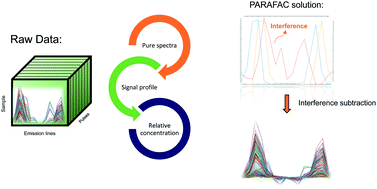Laser-induced breakdown spectroscopy (LIBS) spectra interpretation and characterization using parallel factor analysis (PARAFAC): a new procedure for data and spectral interference processing fostering the waste electrical and electronic equipment (WEEE) recycling process†
Abstract
Laser-induced breakdown spectroscopy (LIBS) was used to characterize base (Al and Cu) and noble (Au and Ag) elements on a printed circuit board (PCB) from a hard disk (HD). A PCB was cut into 77 fragments, and a matrix of 4 rows and 4 columns with 10 laser pulses in each point of the matrix was acquired in each fragment by LIBS. For each element, a spectral range was selected with its respective emission lines and Parallel Factor Analysis (PARAFAC) was used to model the data. LIBS spectra are two-way data, but in this case, the depths were used as a third mode being the data set: samples × variables (emission lines) × depths (laser pulses from 1 to 10). PARAFAC was able to model spectral interference and analyte emission lines in separate components, which allows the removal of the contribution of the concomitants from the measured data. The scores (relative concentrations, mode 1) of the component of interest were used to create a map of the PCB colored by relative concentration, and it was possible to visualize where the element is predominantly located on the PCB. In addition, classification models were applied for Au and Ag using partial least squares discriminant analysis (PLSDA) after removal of the interferents using the PARAFAC result. Good figures of merit were obtained for calibration, cross-validation and validation data sets with accuracy ranging from 0.94 to 1.00. Therefore, the use of PARAFAC and LIBS spectra was very useful, being a great contribution to the LIBS community and urban mining.

- This article is part of the themed collection: Winter Conference on Plasma Spectrochemistry, USA


 Please wait while we load your content...
Please wait while we load your content...